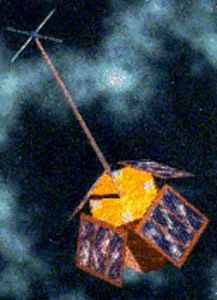
Home - Search - Browse - Alphabetic Index: 0- 1- 2- 3- 4- 5- 6- 7- 8- 9
A- B- C- D- E- F- G- H- I- J- K- L- M- N- O- P- Q- R- S- T- U- V- W- X- Y- Z
REX
 REX Credit: Manufacturer Image |
AKA: Radiation Experiment. Status: Operational 1991. First Launch: 1991-06-29. Last Launch: 1996-03-09. Number: 2 . Gross mass: 85 kg (187 lb). Height: 0.56 m (1.83 ft).
Rex 2 was also the first spacecraft to successfully employ GPS navigation for full closed loop attitude control.
The basic design features of both REX spacecraft were similar, though there were some obvious differences, i. e. no GPS equipment on the first REX. Specifications presented here are for Rex 2. The spacecraft was three axis stabilized, nadir pointing to within 5 degrees. Passive attitude control was provided by a 21 foot gravity gradient boom with two 20 inch long nickel/iron magnetic hysteresis rods mounted at the tip for damping purposes (4 lbs. total). Active control was achieved through a pitch bias momentum system, including one wheel and three torque coils. Attitude determination was provided by GPS equipment, coarse sun sensors, and a magnetometer. The primary communications experiment was built by the US Air Force Rome Laboratories. It advanced research on electron density irregularities that caused disruptive scintillation effects on radio signals transmitted through the Earth's ionosphere. Rex II's GPS receivers, supplied by Trimble Navigation, were able to resolve spacecraft position to 100m, velocity to 0.2 m/sec, and attitude to within 0.3 deg.
More at: REX.
Family: Earth, Ionosphere sat, Medium earth orbit. Country: USA. Launch Vehicles: Scout, Scout G-1, Pegasus, Pegasus XL. Launch Sites: Vandenberg, Vandenberg SLC5, Point Arguello WADZ. Agency: USAF STP, CTA Space Systems. Bibliography: 2, 4, 6, 11683, 13022.
1991 June 29 - . 14:00 GMT - . Launch Site: Vandenberg. Launch Complex: Vandenberg SLC5. LV Family: Scout. Launch Vehicle: Scout G-1.
- REX - . Payload: REX 1. Mass: 85 kg (187 lb). Nation: USA. Agency: USAF Rome. Class: Earth. Type: Ionosphere satellite. Spacecraft Bus: GemStar. Spacecraft: REX. USAF Sat Cat: 21527 . COSPAR: 1991-045A. Apogee: 869 km (539 mi). Perigee: 767 km (476 mi). Inclination: 89.50 deg. Period: 101.30 min. Radiation Experiment; tested communications components in high radiation environment. Spacecraft engaged in research and exploration of the upper atmosphere or outer space (US Cat B)..
1996 March 9 - . 01:53 GMT - . Launch Site: Point Arguello. Launch Complex: Point Arguello WADZ. Launch Pad: Aircraft from Vandenberg.. Launch Platform: L-1011. LV Family: Pegasus. Launch Vehicle: Pegasus XL.
- REX-II - . Mass: 85 kg (187 lb). Nation: USA. Agency: USAF STP. Class: Earth. Type: Ionosphere satellite. Spacecraft Bus: GemStar. Spacecraft: REX. USAF Sat Cat: 23814 . COSPAR: 1996-014A. Apogee: 835 km (518 mi). Perigee: 799 km (496 mi). Inclination: 90.00 deg. Period: 101.20 min. LEO Air dropped in Point Arguello WADZ..
Back to top of page
Home - Search - Browse - Alphabetic Index: 0- 1- 2- 3- 4- 5- 6- 7- 8- 9
A- B- C- D- E- F- G- H- I- J- K- L- M- N- O- P- Q- R- S- T- U- V- W- X- Y- Z
© 1997-2019 Mark Wade - Contact
© / Conditions for Use